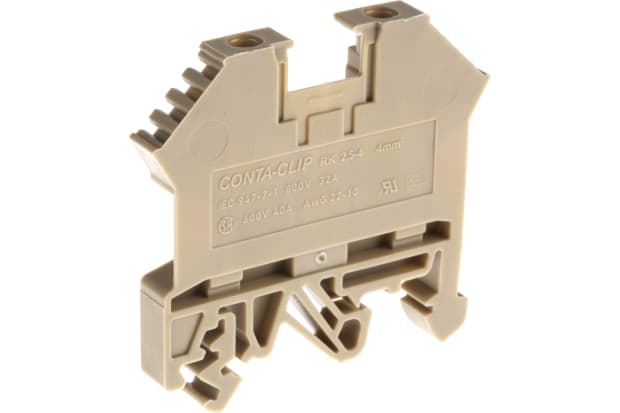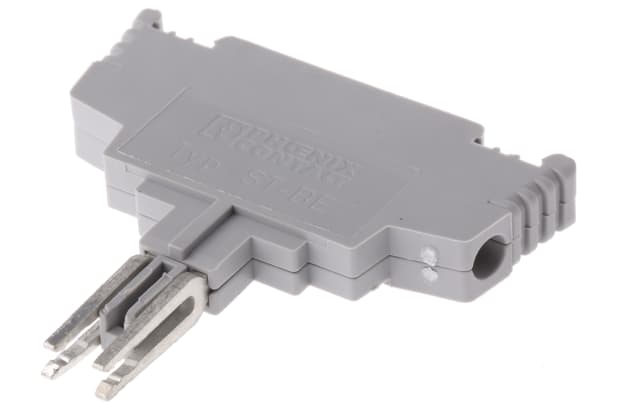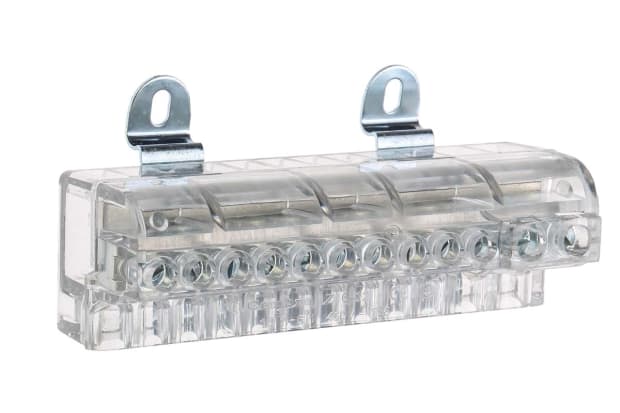- Published 30 Apr 2024
- Last Modified 30 Apr 2024
- 10 min
A Comprehensive Guide to DIN Rail Terminal Blocks
Our DIN rail terminal blocks guide explains what they are, their uses, the different types, and how to use them.

What are DIN Rail Terminal Blocks?

DIN Rail Terminal Blocks, or DIN Rail Connector Blocks, are a type of electrical connector that are used to connect and secure wires. They are designed to be mounted on DIN rails, which are standardised metal rails used for mounting electrical equipment.
The primary function of DIN Rail Terminal Blocks is to provide a secure and organised way to connect and terminate wires. They are commonly used in control cabinets, industrial automation, and other electrical applications.
Key Features of DIN Rail Terminal Blocks
DIN Rail Terminal Blocks are characterised by their ability to simplify wiring tasks. They provide a secure connection point for multiple wires, making it easier to manage complex electrical systems.
These terminal blocks are designed to ensure safety and reliability in electrical connections. They help in preventing short circuits and provide a secure interface for wiring.
What are DIN Rail Terminal Blocks Used for?
DIN Rail Terminal Blocks are used to simplify the wiring process in a wide range of electrical applications. They provide a secure and organised way to connect wires, making them essential for various industries, including manufacturing, automation, and construction.
Electrical Applications
In electrical applications, DIN Rail Terminal Blocks are used to connect wires from different components, such as switches, sensors, and actuators, to create complete and secure electrical circuits.
They are commonly used in industrial settings, such as manufacturing plants, where they help to simplify the wiring of complex machinery and equipment.
Control and Automation
In control and automation systems, DIN Rail Terminal Blocks play a crucial role in providing a structured and secure way to connect wires. They are often used in control cabinets and panels to organise and manage the wiring of control systems, making them essential for industries like building automation and industrial control.
Building and Construction
In building and construction, DIN Rail Terminal Blocks are used in electrical distribution panels to simplify the wiring of circuits. They help to ensure that electrical connections are secure and well-organised, which is essential for maintaining the electrical systems in buildings and other structures.
Key Benefits of DIN Rail Terminal Blocks
DIN Rail Terminal Blocks offer several key benefits, including simplifying wiring tasks, ensuring secure connections, and providing a structured approach to managing electrical connections.
They help to reduce the risk of wiring errors and make it easier to troubleshoot and maintain electrical systems.
What are DIN Rail Terminal Connectors?

DIN Rail Terminal Blocks, also known as DIN Rail Terminal Connectors, are a fundamental component in electrical systems. They are used to create secure and reliable connections between wires.
DIN Rail Terminal Connectors are designed to be mounted on DIN rails, providing a convenient and organised way to manage wiring in control cabinets, industrial automation, and other electrical applications.
Key Features of DIN Rail Terminal Connectors
DIN Rail Terminal Connectors are characterised by their ability to simplify the process of connecting and terminating wires. They provide a secure interface for wiring, helping to prevent short circuits and ensuring the safety and reliability of electrical connections.
These connectors are available in various types and configurations to accommodate different wire sizes and connection requirements. They are typically made from durable, high-quality materials to ensure long-term performance in demanding industrial environments.
Types of DIN Rail Terminal Blocks
DIN Rail Terminal Blocks come in a variety of types, each designed for specific applications and wiring needs. Understanding the different types of DIN Rail Terminal Blocks is essential for selecting the right components for your electrical project.
Standard DIN Rail Terminal Blocks
Standard DIN Rail Terminal Blocks are the most commonly used type. They provide a simple and secure way to connect wires of various sizes. These terminal blocks typically feature screw-type connections that allow wires to be easily inserted and tightened for a reliable connection.
Standard DIN Rail Terminal Blocks are versatile and used in a wide range of applications, from industrial machinery to building automation.
Fused DIN Rail Terminal Blocks
Fused DIN Rail Terminal Blocks are equipped with built-in fuses, adding an extra layer of protection to your electrical circuits. Fuses are essential for preventing overcurrent and short circuits, making these terminal blocks ideal for applications where circuit protection is a priority.
Fused DIN Rail Terminal Blocks are commonly used in sensitive electronic equipment, control panels, and industrial machinery to safeguard against electrical faults.
Ground (Earth) DIN Rail Terminal Blocks
Ground, or Earth, DIN Rail Terminal Blocks are specifically designed to provide a secure connection for grounding wires. Grounding is essential for ensuring electrical safety by directing excess electrical current to the earth, preventing electrical shocks and protecting equipment.
These terminal blocks typically feature distinct markings and are used exclusively for grounding purposes in electrical panels and industrial applications.
Power Distribution DIN Rail Terminal Blocks
Power Distribution DIN Rail Terminal Blocks are engineered to handle high current and voltage levels, making them suitable for power distribution applications.
These terminal blocks are designed to accommodate larger wire sizes and provide a secure connection for heavy-duty power cables. They are commonly used in electrical panels and industrial settings to efficiently distribute power throughout a system.
Disconnect DIN Rail Terminal Blocks
Disconnect DIN Rail Terminal Blocks feature a unique design that allows for the easy disconnection of wires without the need for tools. This can be useful for maintenance, troubleshooting, or quickly isolating a specific part of the circuit.
These terminal blocks are commonly used in applications where the ability to disconnect wires swiftly and safely is essential, such as in industrial control panels and machinery.
Key Considerations for DIN Rail Terminal Blocks
When selecting DIN Rail Terminal Blocks for your project, there are several key considerations to keep in mind.
Compatibility
Ensure that the terminal blocks you choose are compatible with the wire sizes and types you intend to use. This includes considering the type of connection, whether it's screw-type, spring-loaded, or other variations.
Current and Voltage Ratings
Be mindful of the current and voltage ratings of the terminal blocks. Different applications require terminal blocks that can handle specific levels of electrical current and voltage to ensure safety and optimal performance.
Wire Termination
Consider the wire termination method supported by the terminal blocks. Some terminal blocks offer flexibility with various termination options, including screw-type, spring-cage, or push-in connections. Choose the method that aligns with your project's requirements.
Additional Features
Evaluate any additional features that may benefit your project, such as built-in fusing, LED indicators, or disconnect switches. These features can enhance safety, simplify troubleshooting, and provide added functionality to your electrical system.
DIN Rail Terminal Block Sizes
DIN Rail Terminal Blocks come in various sizes to accommodate different wire capacities and types.
The size of a DIN Rail Terminal Block is typically determined by the number and type of wires it can accommodate.
The most common sizes include small, standard, and large, each suitable for different applications.
Wire Capacity
The wire capacity of a terminal block is a crucial factor in determining its size. Smaller terminal blocks are designed for fewer and smaller wires, while larger ones can accommodate a more significant number of wires with varying thicknesses.
Compatibility
When selecting a DIN Rail Terminal Block, it's essential to ensure compatibility with the wire sizes and types you intend to use. This includes considering the type of connection, whether it's screw-type, spring-loaded, or other variations.
Application Specificity
The size of the terminal block should align with the specific requirements of your application. Smaller terminal blocks are suitable for applications with limited space, while larger ones are typically used in scenarios where more extensive wiring is necessary.
Scalability
Consider the scalability of your electrical system. Choosing terminal blocks of the appropriate size allows for easier expansion and modification of your system in the future.
How to Use a DIN Rail Terminal Block
Using a DIN Rail Terminal Block is a straightforward process, but it's essential to follow the correct steps to ensure a secure and reliable connection.
Mounting on a DIN Rail
The first step is to mount the DIN Rail Terminal Block onto a DIN rail. Most terminal blocks are designed for quick and easy attachment to DIN rails. Simply slide the terminal block onto the DIN rail and ensure that it securely latches into place.
Connecting Wires
Once the terminal block is mounted, you can proceed to connect the wires. Depending on the type of terminal block, you'll typically insert the wires into the designated wire entry points.
For screw-type terminal blocks, you'll need to loosen the screws, insert the wires, and then tighten the screws to secure the connection.
For spring-loaded or push-in type terminal blocks, you'll simply insert the wires into the corresponding openings, and the mechanism will automatically secure the wires in place.
Ensure that the wires are inserted correctly and make good contact with the terminal to prevent any loose connections.
Wire Stripping
Before inserting the wires, it's essential to strip the wire insulation carefully to expose the bare wire. The length of the stripped portion should match the terminal block's specifications.
Use wire strippers to remove the insulation, takingcare to avoid damaging the wire conductors. Most terminal blocks will have markings indicating the required strip length.
Securing the Connection
After inserting the wires, ensure that each wire is securely connected. For screw-type terminal blocks, tighten the screws to establish a firm connection.
Testing the Connection
Once the wires are connected, it's important to test the connection to ensure that it's secure and that the wires are making proper contact.
Gently tug on each wire to check if it's firmly held in place. If the wire comes loose, reinsert and secure it again.
How to Wire a DIN Rail Terminal Block
Wiring a DIN Rail Terminal Block is a fundamental skill for anyone working with electrical systems. Here's a step-by-step guide on how to wire a standard screw-type DIN Rail Terminal Block:
Step 1: Preparation
Begin by turning off the power to the electrical circuit you'll be working on. This is a crucial safety step to prevent electrical shocks or accidents.
Step 2: Wire Stripping
Carefully strip the insulation from the ends of the wires you intend to connect to the terminal block. Use wire strippers to remove the insulation, taking care to avoid damaging the wire conductors. The length of the stripped portion should match the terminal block's specifications. Most terminal blocks will have markings indicating the required strip length.
Step 3: Inserting the Wires
Identify the wire entry points on the terminal block. Loosen the screws on the terminal block's contact points to create openings for the wires.
Insert the stripped wire ends into the designated slots based on the wire's gauge. Ensure that the wires are inserted all the way into the terminal block.
Step 4: Securing the Connection
Tighten the screws on the terminal block to secure the wires in place. This ensures a strong and reliable connection.
Use a screwdriver to tighten the screws, making sure that the wires are held firmly.
Step 5: Testing the Connection
After securing the wires, perform a final check. Gently tug on each wire to ensure they are held firmly in place. If any wire feels loose, re-tighten the screw to secure the connection.
Step 6: Organising the Wiring
Once all the wires are connected, organise the wiring to maintain a neat and tidy appearance. Proper organisation makes it easier to troubleshoot and maintain the system in the future.
Step 7: Re-energise the Circuit
After completing the wiring, you can turn the power back on and test the circuit to ensure it's functioning as intended.
Popular Brands of DIN Rail Terminal Blocks
Several reputable brands are known for manufacturing high-quality DIN Rail Terminal Blocks. Here are a few of the most popular brands that are trusted by professionals in the electrical industry:
Phoenix Contact
Phoenix Contact is a leading manufacturer of electrical connection, electronic interface, and industrial automation technologies. They offer a wide range of DIN Rail Terminal Blocks known for their reliability and innovative features.
Weidmüller
Weidmüller is a global leader in the manufacturing of electrical connectivity, transmission, and conditioning of power, signals, and data in industrial environments. Their DIN Rail Terminal Blocks are known for their precision and high performance.
Related links
- DIN Rail Terminal Blocks
- Standard Terminal Blocks
- Phoenix Contact Pluggable Terminal Block 2788304
- 8WA Terminal Block for use with for use with Terminal Blocks
- Phoenix Contact DIN Rail Terminal Blocks
- Phoenix Contact UDB Series Brown Non-Fused Terminal Block Screw Termination
- Phoenix Contact Combi Pluggable Solutions Pluggable Terminal Block DIN Rail, Screw
- Phoenix Contact Combi Pluggable Solutions Plug Spring Cage



